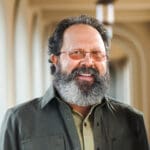There is much confusion and misinformation in our time regarding the compatibility of Buddhism and Catholicism. Dr. Clark is both a faithful Catholic and a Chinese scholar (he reads Chinese fluently), his work is well researched, solid, trustworthy, and charitable. Joined with Carl Olson, an excellent theologian, there is no better combination of authors to shed light on this important topic. We are grateful for their efforts in this realm and submit this treatment for your consideration.
Catholicism and Buddhism by Anthony E. Clark and Carl E. Olson
Near the end of his life the Trappist monk and author Thomas Merton said that he wanted “to become as good a Buddhist as I can.” A contemporary priest, Robert E. Kennedy, S.J., Roshi (Zen master), holds Zen retreats at Morning Star Zendo in Jersey City. He states on his web site: “I ask students to trust themselves and to develop their own self-reliance through the practice of Zen.” Meanwhile, the St. Francis Chapel at Santa Clara University hosts the weekly practice of “Mindfulness and Zen Meditation.” Similarly, there are a growing number of Buddhist retreats and workshops being held in Catholic monasteries and parishes.
Today there is a proliferation of resources and retreats dedicated to combining Zen Buddhism and Catholicism, suggesting that the Catholic Church has finally “awakened” from its “outdated” and “exclusivist” ecclesiology. While Buddhism has not been in the news recently as much as Islam, its influence and attraction has steadily increased in the West.
Is Catholicism really “parallel” to Buddhism? Can Catholic doctrine be reconciled with Buddhist beliefs and practices?
The Coming of Buddhism
Buddhism is the fourth largest religion in the world, with about 370 million adherents, or about 6% of the world’s population. Although less than 1% of Americans identify themselves as Buddhist, interest in this ancient belief system is growing. Sections on Buddhism in major bookstores usually dwarf those dedicated to Islam or Hinduism and there has been a steady stream of articles and books about (and by) the Dalai Lama in recent years. Some stores even display the Dalai Lama’s works beside those of Pope John Paul II, hinting at the “similarities” of the Buddhist and Catholic faiths.
The influence of Buddhist thought in some Catholic circles has been evident since the 1960s. In the wake of the Second Vatican Council’s call for respectful dialogue with other religions, many Catholics, including many priests and religious, dove headlong into studying Buddhism. Much was made (and still is) of the many “common characteristics” of Catholicism and Buddhism, especially in the realm of ethics. External similarities, including monks, meditation, and prayer beads, seemed to indicate a newly discovered closeness between the followers of Christ and Buddha. While some helpful interreligious dialogue and study was accomplished, some Catholics mistakenly concluded that Buddhism was just as “true” as Christianity, and that any criticism of Buddhism was “arrogant” and “triumphalistic.”
This attitude still exists, of course, as do attempts to combine the two faiths. It’s not uncommon for Catholic retreat centers to offer a steady diet of classes and lectures about Zen Buddhism, Christ and Buddha, and even “Zen Catholicism.” Their bookstores feature titles such as Zen Spirit, Christian Spirit, Jesus and Buddha: The Parallel Sayings, and Going Home: Jesus and Buddha As Brothers. Comparisons are often made between Christian mysticism and Buddhist mysticism, at times suggesting that the two are essentially identical in character and intent.
The Attraction of Buddhism
In Crossing the Threshold of Hope, the Holy Father notes that the Dalai Lama has worked to bring “Buddhism to people of the Christian West, stirring up interest both in Buddhist spirituality and in its methods of praying.” He points out that, “Today we are seeing a certain diffusion of Buddhism in the West.” So what makes this diffusion possible and so influential?
Buddhism is attractive for numerous reasons. Among them is the desire for spiritual vitality in the midst of the emptiness of secular life, the promise of inner peace, and the need for an explicit moral code. In his classic study, Buddhism: Its Essence and Development, Edward Conze writes, “To a person who is thoroughly disillusioned with the contemporary world, and with himself, Buddhism may offer many points of attraction, in the transcending sublimity of the fairy land of its subtle thoughts, in the splendor of its works of art, in the magnificence of its hold over vast populations, and in the determined heroism and quiet refinement of those who are steeped into it.”
Another key appeal of Buddhism is its non-dogmatic and seemingly open-minded character. For those who reject the dogmatic and objective claims of Christianity, or who believe that Christianity should avoid an “exclusive” or absolute approach to truth, Buddhism offers an easier alternative. In addition, some Christians find solace in believing that their faith in Christ and Buddhism are compatible.
As the Dalai Lama stated in a Beliefnet.com interview, “According to different religious traditions, there are different methods. For example, a Christian practitioner may meditate on God’s grace, God’s infinite love. This is a very powerful concept in order to achieve peace of mind. A Buddhist practitioner may be thinking about relative nature and also Buddha-nature. This is also very useful.” In other words, Christianity and Buddhism are two ways to the same end; Jesus and Buddha are two enlightened teachers who help man to that end. Or, as one reader on a Christian discussion forum states, “Buddha was just a philosopher who urged men to be selfless. Jesus was just a philosopher who urged men to be selfless. Love is just another word for selfless.” Such easy parallels between Christ and Buddha are, in the end, misleading and distort the teachings of the Church.
The Basics of Buddhism
Since Buddhism appears less concerned with dogma or doctrine than right living, is it compatible with Catholic doctrine? A glance at Buddhist basics will help answer this question.
Buddha (c. 563-c. 483 B.C), born Siddhartha Gautama, was the son of a king in India. Around the age of thirty he left his privileged life in court to became an ascetic, and spent several years traveling and meditating on the human condition, considering especially the reality of suffering. One day, meditating beneath a bodhi tree, he became enlightened (Buddha = “enlightened one”), and afterward began to teach his dharma, or doctrine, of the Four Noble Truths.
The Four Noble Truths are that (1) life is suffering, (2) the cause of suffering is desire, (3) to be free from suffering we must detach from desire, and (4) the “eight-fold path” is the way to alleviate desire. The eight-fold path includes having right views, intentions, speech, actions, livelihood, effort, mindfulness, and concentration. The final goal of Buddhism is not merely to eradicate desire, but to be free of suffering.
Buddha also taught the “three characteristics of being”: that all things are transitory, there is no “self” or personality, and this world brings only pain and suffering. To accept the existence of anything involves giving birth to its opposite (i.e., love and hate, joy and fear, etc.), which results in a duality of “good” and “bad.” Nirvana, literally, “putting out a fire,” is the extinction of self and the escape from the cycle of reincarnation. A Buddhist might allow one to believe in an afterlife, but such an allowance is called upaya, an expedient means to a real end. That is, upaya allows belief to exist as a means to an end; all religious belief, including Buddhism itself, is merely a construction. According to Buddhist upaya, Christianity is allowable as long as it is viewed as a stage of spiritual progression, leading eventually to the extinction of self – nirvana. In the two major forms of Buddhism, Hinayana and Mahayana, the latter teaches that man is already “extinguished,” he just needs to realize it.
It is sometimes said that Buddhism is atheistic. Yet Buddhism is not interested in the question of God, so it is more accurate to describe it as agnostic. Buddhism “works” whether or not there is a God. A Buddhist allows others to believe in a God or gods, but such beliefs are merely convenient means to the final end, which has nothing to do with a God or gods. “God is neither affirmed nor denied by Buddhism,” wrote Merton in Mystics and Zen Masters, “insofar as Buddhists consider such affirmations and denials to be dualistic, therefore irrelevant to the main purpose of Buddhism, which is emancipation from all forms of dualistic thought.”
Important Distinctions and Deep Divides
Despite many external similarities, Buddhist meditation and contemplation is quite different from orthodox Christianity. Buddhist meditation strives to “wake” one from his existential delusions. “Therefore, despite similar aspects, there is a fundamental difference” between Christian and Buddhist mysticism, wrote John Paul II. The Holy Father continued: “Christian mysticism . . . is not born of a purely negative ‘enlightenment.’ It is not born of an awareness of the evil which exists in man’s attachment to the world through the senses, the intellect, and the spirit. Instead, Christian mysticism is born of the Revelation of the living God.”
Catholics believe that the Church is the Body and Bride of Christ, the seed of the Kingdom of God, and the conduit of God’s grace and mercy in the world. Buddhists believe that Church, or Sangha, is in the end, upaya, nothing more than the expedient means to ultimate extinction. Rather than the Beatific Vision, Buddhist teaching holds that non-existence is the only hope for escaping the pains of life.
The Catholic Church teaches that while suffering is not part of God’s perfect plan, it does bring us closer to Christ and unite us more intimately with our Suffering Lord. Buddhism teaches that suffering must be escaped from; indeed, this is a central concern of Buddhism. Christianity is focused on worshipping God, on holiness, and the restoration of right relationships between God and man through the Person and work of Jesus. The Buddhist, however, is not concerned with whether or not God exists, nor does he offer worship. Instead, he seeks after non-self (anatman).
Catholicism believes that truth, and the Author of Truth, can be known rationally (to a significant, yet limited, extent) and through divine revelation. In contrast, Buddhism denies existential reality; nothing, including the “self,” can be proven to exist.
Dialogue and Danger
Romano Guardini, in his classic work The Lord, stated that Buddha would be the greatest challenge to Christ in the modern age. In an age of terrorism, such a statement may appear to be an exaggerated concern, but Buddhism offers Christianity serious and subtle challenges. Because it appears to be peaceful, non-judgmental, and inclusive, its appeal will undoubtedly continue to grow. Because it offers a spirituality that is supposedly free of doctrine and authority, it will attract hungry souls looking for fulfillment and meaning. “For this reason,” the Holy Father states, “it is not inappropriate to caution those Christians who enthusiastically welcome certain ideas originating in the religious traditions of the Far East – for example, techniques and methods of meditation and ascetical practice.” As he correctly observes, “In some quarters these have become fashionable, and are accepted rather uncritically.”
Nostra Aetate, Vatican II’s Declaration on the Relationship of the Church to Non-Christian Religions, states that “Buddhism, in its various forms, realizes the radical insufficiency of this changeable world; it teaches a way by which men, in a devout and confident spirit, may be able either to acquire the state of perfect liberation, or attain, by their own efforts or through higher help, supreme illumination.” It continues to note that, “The Catholic Church rejects nothing that is true and holy in these religions” and believes that other religions, in certain ways, “often reflect a ray of that Truth which enlightens all men.”
But, the document insists, the Church “proclaims, and ever must proclaim Christ ‘the way, the truth, and the life’ (John 14:6), in whom men may find the fullness of religious life, in whom God has reconciled all things to Himself” (par 2). While the Council affirms that Buddhism may contain a “ray of Truth,” it does not endorse appropriation of Buddhist beliefs into Christian practice. Rather, the Council insists that non-Catholic religions can be fulfilled only through the truths held exclusively by the Church.
In Buddha’s final words to his disciples under the sala trees, he said, “Make of yourself a light. Rely upon yourself; do not rely upon anyone else. Make my teachings your light. Rely upon them; do not depend upon any other teaching.” When the Fourth Evangelist described John the Baptist, he said, “He was not himself the light, but was to bear witness to the light” (John 1:8). He continued by proclaiming that Christ “is the true light that enlightens every man who comes into the world” (John 1:9). Christ, the “true light,” did not teach His followers to extinguish their fires, such as is [the] meaning of nirvana, but to illuminate the world with His love, and to reflect the light of His truth.
Christ and Buddha compared
In his Fundamentals of the Faith, Peter Kreeft writes that “there have only been two people in history who so astonished people that they asked not ‘Who are you?’ but ‘What are you? A man or a god’ They were Jesus and Buddha.”
He then contrasts the striking differences between the two men: “Buddha’s clear answer to this question was: ‘I am a man, not a god’; Christ’s clear answer was: ‘I am both son of Man and Son of God.’ Buddha said, ‘Look not to me, look to my dharma [doctrine]’: Christ said, ‘Come unto me.’ Buddha said, ‘Be ye lamps unto yourselves’; Christ said, ‘I am the light of the world.'”
It is presently common to find Christ brought down to the level of “philosopher” or “great teacher,” just as Buddha is sometimes elevated to a state of divinity. Yet there remain profound differences between the two.
РChrist claimed to be the one and only true God who came to suffer, die, and rise again, establishing a unique and everlasting covenant with man. Buddha is believed to be one of many thaṭgata (thus-come-one). The historic Buddha is just one of several thaṭgata who come in various ages to teach man that life is an illusion and to strip away human desires and attachments.
– Christ taught that He is “the Way, the Truth, and the Life.” Buddha teaches that every person must find their own path to enlightenment, or nirvana, the extinction of self.
– Christ preached the reality of sin, the nature of God the Father, and the need for repentance and salvation. Buddha preached the untenable nature of existence and the means to escape suffering.
– Christ taught that God is completely Other, but also taught that God wishes to share His divine life, given through the Son by the power of the Holy Spirit. Buddha taught individuality must perish and that everything is One.
– Christ established a Church, with a structure of authority, based on His words and Person. Buddha left a teaching in which each person must find his own path.
– Christ rose from the dead, once and for all, and is returning as King of Kings. He claimed divinity by saying, “Truly, truly, I say to you, before Abraham was born, I am.” (John, 8:58). For Buddhists, Buddha is a model, regardless of whether or not he was a historical person. Buddha suggests that, “There is no ‘I’; there is no ‘self’.” At his death, when he experienced pari-nirvana, or “final extinction,” he stated that the question of the afterlife was, “not conducive to edification.” What’s important is that man escapes desire by being extinguished.
This post originally appeared in Ignatius Insight in February 2005, and in a slightly different form in the May/June 2005 issue of This Rock magazine [now Catholic Answers]
- Anthony E. Clark, Ph.D. is an Associate Professor of East Asian history at Whitworth University. His

Dr. Anthony E. Clark research centers on the history of Western missionaries in China, especially during the late 19th and early 20th centuries. He received his doctorate from the University of Oregon, where he studied Chinese history, philosophy, and religion. He is author of several academic and popular works, including books and articles on Chinese historiography, cultural interaction between China and the West, and his primary interest, the history of Sino-Western religious and cultural re-presentation during China’s late imperial to early modern era. He has also been researching the history of Catholic martyrs in China and has recently [2005] finished writing a book on that subject. Dr. Clark has presented papers at numerous academic conferences and has also been a guest on “EWTN Live” and “Catholic Answers Live” to talk about Catholicism in China. He is also a contributing editor for This Rock magazine [now Catholic Answers]
-

Carl E. Olson Carl E. Olson is the editor of IgnatiusInsight.com. He is the co-author of The Da Vinci Hoax: Exposing the Errors in The Da Vinci Code and author of Will Catholics Be “Left Behind”? He resides in a top secret location in the Northwest somewhere between Portland, Oregon and Sacramento, California. Visit his personal web site at www.carl-olson.com.
Post and artwork/photography used with permission.
Editor’s Note: Links to all posts in our “Can I Trust?” Series can be found HERE.






